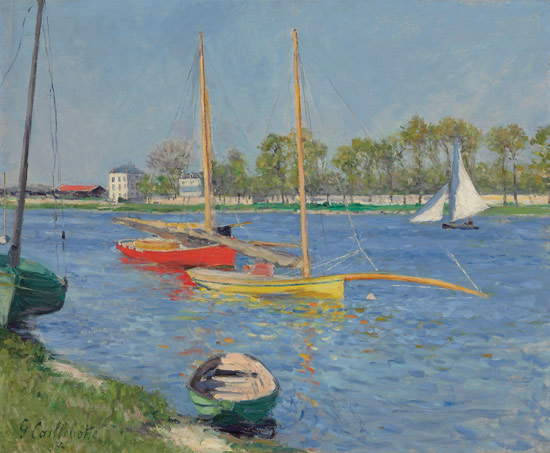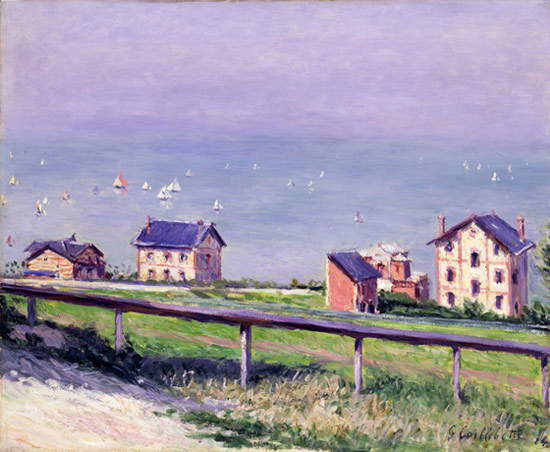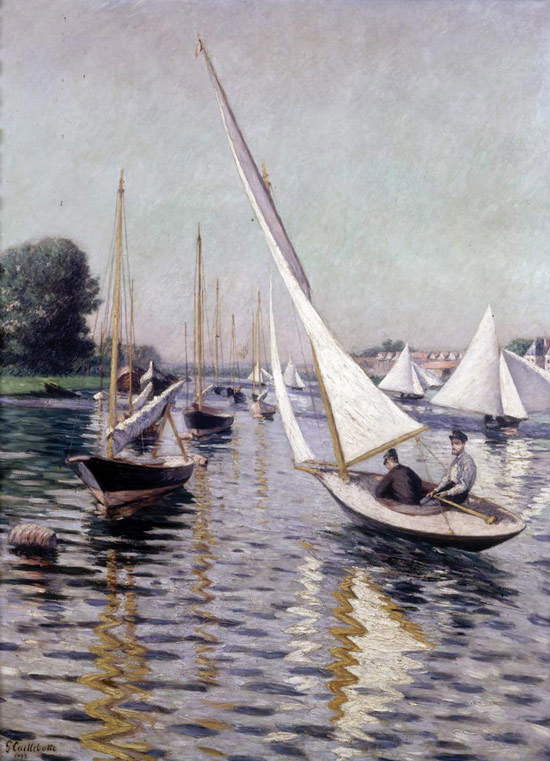"To give a better idea of this type of boat, I could do no better than to mention the Condor of Monsieur Caillebotte, the grand chief and most pleasant of the independent painters of the rue des Pyramides. She has a 7.40-meter keel and measures 8.20 meters from end to end. Her width is 2.50 meters and she has a sail area of 97 square meters, divided between 66 in the mainsail and 31 in the jib. The superiority of this boat must be attributed both to her good form and to the happy attempt of her owner who tried to have the sails made of silk." The excerpt, taken from a late 19th-century magazine, describes one of the sailboats of Gustave Caillebotte (Paris, 1848 - Gennevilliers, 1894), the great Impressionist painter, who in addition to being an art collector as well as a patron of many of his colleagues, was also a keen sailor, taking part in numerous regattas in France. He even manages to win them.
The artist buys his first racing boat in 1878: he decides to name it Iris. Several others follow, many of which have very distinctive names. One, for example, is called Roastbeef. Yet another is called Cul-Blanc. And even the name Condor, which apparently calls to mind the well-known South American bird of prey, is nothing more than a play on words, because the word “condor” in French is pronounced exactly like the expression “con d’or,” where “con” is the vulgar name for the female genital organ, and “d’or” means “golden” (in Italian it would sound, just to be explicit, like “golden pussy”). As anticipated, Caillebotte began racing his boats, which were often also designed by him. Belgian historian (and yachtsman) Daniel Charles reconstructed Gustave Caillebotte’s sporting career in an essay for a volume onImpressionism in Gennevilliers released in 1993. It was in 1876 that the artist joined, along with his brother Martial and friend Maurice Brault, the Cercle de la Voile de Paris, the Paris Sailing Club, whose headquarters were located very close to the apartment where Caillebotte lived. From downtown Paris to Argenteuil, where the club’s sailors keep their boats and where they train, it takes just over twenty minutes by train. And in the late 1970s the artist, in his thirties, travels often to the small town on the outskirts of Paris, because he has never skippered a sailboat, and needs to learn, obviously as a member of experienced crews. However, Caillebotte wants to become an accomplished sailor: he trains hard and with great perseverance (he comes from a very wealthy family, and his economic faculties allow him to devote much of his day to sailing) until, after a few months, he is able to command a yacht.
 |
| The first issue of Le Yacht |
And could sailing have been absent from Caillebotte’s artistic output? Of course not: one of the earliest works on the theme depicts precisely Ines and Condor together. It is a signed and dated painting that dates from 1882 and was sold at auction by Christie’s in 2010 for the remarkable sum of more than five million dollars. Ines is on the left, she is the one with the red hull. Condor, on the other hand, is the boat with the yellow hull: the fact that it has been depicted in the exact center of the scene, with the mast dividing the composition into two almost equal parts, is indicative of Condor being Gustave Caillebotte’s favorite boat. Another boat sails further back, while a couple are moored on the shore near us. Of the other shore we see, outlined with brief touches of brush, the trees along the river. Skillfully placed spots of color on the waters of the Seine offer the viewer the impression of boats reflected in the river. This is one of the earliest works on the theme of sailing (in total, Caillebotte will produce about forty): it is a rather conventional painting, inspired by the similar compositions that Claude Monet had made precisely at Argenteuil (indeed, it can almost be said that Caillebotte “discovered” Argenteuil also thanks to Monet) although, compared to his colleague’s, Caillebotte’s work appears to us more immediate. This effect is also due to the rapidity with which the artist usually completed his works in this period.
 |
| Gustave Caillebotte, The Seine at Argenteuil (1882; oil on canvas, 59.7 x 73.7 cm; private collection) |
However, compared to the paintings that Caillebotte had made in Paris, and which were marked by peculiarities that made them impressionisti.php' target='_blank'>highly innovative (just think of the photographic slant that the artist had been able to give to several of his achievements), the works executed in Argenteuil return to embrace an Impressionism close to that of his early days. Even a work such as Boats Sailing at Argenteuil, kept at the Musée d’Orsay, seems to approach Monet’s art considerably. Here, several boats with white sails ply the Seine beyond the small wooden pier that the artist wanted to place in the foreground. Almost as if to recall the latter element, in the background we notice the railroad bridge, beyond which we glimpse the green outline of the hills of Sannois, a settlement not far from Argenteuil: at the time when Caillebotte painted they were all villages surrounded by greenery, while today they have become heavily urbanized suburbs of the Paris suburbs. The sailboats in the painting all move within the space delimited by the two bridges: Caillebotte shows particular interest in creating a decidedly balanced and equilibrated composition (it is easy to see how much the work is built on horizontal and vertical lines: Caillebotte, among Impressionist painters, is certainly one of the most... orderly). But the artist also reveals a keen sense for luministic effects: the reflections of the boats on the water and the dazzling glare of the sunlight seem more studied than in the 1882 painting. This work, in fact, dates from around 1888: six years earlier, Caillebotte had bought a house in Argenteuil, right on the bank of the Seine, but it was only from 1887 onward that he began to frequent it regularly until he decided to settle there. The view we see in the Musée d’Orsay painting is not far from the painter’s house.
 |
| Gustave Caillebotte, Boats at Argenteuil (ca. 1888; oil on canvas, 65 x 55.5 cm; Paris, Musée d’Orsay) |
Regattas are, of course, also a source of great interest to the artist, who does not fail to depict races in his compositions. As a frequent visitor to the coasts of Northern France, as well as a yachtsman involved in the regattas held in Normandy, Caillebotte painted, in 1884, a work depicting a competition in the waters of the English Channel in front of the village of Villerville, not far from the town of Trouville, a frequent destination for Impressionist painters: Caillebotte, too, especially in the 1880s, often stayed in this area of Normandy. It is a truly evocative work: the artist paints the regatta from above, from the hill of Villerville, so much so that we see in the foreground the meadows and the houses of the village, built in many cases recently (this area is experiencing, just in these years, a remarkable tourist development), while the boats that are competing for the prize are far away (some of them were made just with a single brush stroke), and they are plying a sea that Caillebotte depicts in various shades of blue and azure to best capture the effects of light on the water, a sea that in the distance blurs with the sky in an atmospheric rendering caught in the moment, typical of Impressionist painting. It is safe to assume that the artist made the work, or at least painted much of it, outdoors on a hot summer day such as the one the painting is meant to suggest.
 |
| Gustave Caillebotte, Regatta at Villerville (1884; oil on canvas, 60.3 x 73 cm; Toledo - Ohio, Toledo Museum of Art) |
 |
| Gustave Caillebotte, Regatta at Argenteuil (1893; oil on canvas, 157 x 117 cm; private collection) |
While in the 1970s and 1980s the focus of paintings on the theme of sailing were mainly on races or glimpses of the Seine and the English Channel with boats plying their waters, in the 1990s Caillebotte showed an interest in offering close-ups of boats or, at the very least, in describing yachts in a precise manner: this was partly because, during this period, Caillebotte, in addition to being an accomplished sailor, also became a designer of sailboats, regularly sending designs to shipyards on the Seine to have racing boats built. In one of his last works, known as Regatta at Argenteuil, from 1893, the clippers racing on the Seine are depicted, albeit in typically Impressionist immediacy, with great rigor and a keen eye. But this is not the only reason why this work is among the most interesting of the last phase of the artist’s career. It is also interesting because in the clipper we observe in the foreground, in front of everyone else, Gustave Caillebotte wanted to self-represent himself in the role of helmsman. This is the last time the artist depicted himself in a painting: a kind of poetic testament, which the painter wished to entrust to the sail, the passion that for nearly two decades filled the days of an artist who made a fundamental contribution to the history of Impressionism, and thus to the history of art.
Reference bibliography
Warning: the translation into English of the original Italian article was created using automatic tools. We undertake to review all articles, but we do not guarantee the total absence of inaccuracies in the translation due to the program. You can find the original by clicking on the ITA button. If you find any mistake,please contact us.